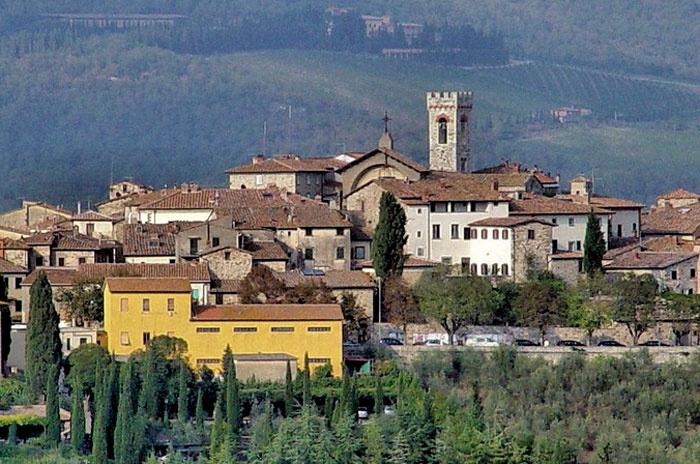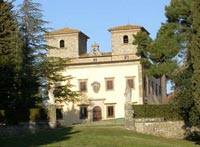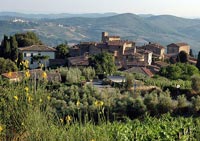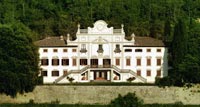 |
Radda in Chianti |
Radda in Chianti |
| Radda stands on a hill covered with woods and vineyards, which lies between the Pesa and Arbia Valleys. Feudal lords and other powerful men exercised their dominion over this area: first of all the Marquises of Tuscany, then the Emperors Arrigo VI and Federico II and the noble Guidi family. At the beginning of the 13th. century, the Commune of Florence annexed Radda among its possessions. The town first became the seat of one of the three Commanders of the Chianti League and then, in the early 1400s, that of the podestà and, in 1415, at the express wish of the Medici, it became the chief town of the entire League. During its history it has seen the battles against Siena, the assault of the Aragonese (who set fire to the town), and also a period of decline towards the end of the 18th. century. The Museum of Sacred Art of Chianti deserves a visit. Set in the Franciscan Convent of Santa Maria in Prato, it displays several works of art from the Chianti region, including a valuable polyptich by Neri di Bicci (1474) depicting the Virgin Mary with child and saints. |
|
||
| Once this belonged to the fortification system of the Albola Castle, but during the centuries it has been transformed into wine factory and villa. The oldest buildings on the estate date from the 12th century, when the property was owned by the noble Magnate of Monterinaldi. It was subsequently owned by families who shaped Tuscan history: the Acciaiuoli, the Samminiati, the Pazzi and the Princes of Ginori Conti. The Zonin family acquired the property in the 1970s. Tte Zonin Family, have 12 wineries. One in Virginia (US) and 11 in Italy (4 in Tuscany). The oldest part of Pian d’Albola dates back from early 12th century, while the real villa has been added around 1725. The property consists of 850 hectares, of which 157 are devoted to specialized vineyards, distributed among various holdings - Mondeggi, Selvole, Ellere, Bozzolo, Sant'Ilario, Casa Nova, Acciaiolo, Madonnino, Fagge, Montemaioni, Montevertine, Crognole and Vignale. Some of these holdings have given their names to the wines of the estate. |
 Villa Albola |
|
The documents contain details of transactions and of legal proceedings, (found not actually at Albola but in the villages nearby), the law that the contracting parties declare that they are following is none other than the Natio Longobarda. But returning to the history of the village itself, the first document in which the name Albola is mentioned is dated 8th June, 1010. In it Arnolfo II, archbishop of Milan, establishes the working conditions for some of the inhabitants of Albola who had to cultivate the ten farms that the Milanese clergy owned in that zone. Indeed, it was then quite normal for the Church to extend its landed property by means of purchases or donations - just as S. Ambrosio had done in the past - even in far-away regions such as Tuscany. Those ten small farms, entrusted to the bailiff Gariardo and his heirs for twenty-nine years, were capable of supporting ten families. In the 12th and 13th centuries, it was the magnates of Monterinaldi who gained possession of the lands of Albola and governed them. In the meantime, the ten farms of the beginning of the Millenium have become the Curtis di Albola, a new kind of conglomeration that also includes a small castle or the residence of its feudal lord. We also learn that the area of Albola forms part of the dominions of Florence, as shown by the use of Florentine measures for cereals and the inhabitants’ declared obedience to Florentine statutes. Albola will also be one of the first small communes to become confederated (1306) in the newly-formed Chianti League (see the section on The Chianti Area). The Acciaiuoli Family at Albola Among the important Florentine families with interests in the zone of Albola at the time there was, in particular, the Acciaiuoli family, who wanted to establish a sizeable land holding in the area. The Samminiati FamilyAnother great Florentine noble family, the Samminiatis, owned lands bordering on those of Albola. And in 1636 one of its members, Ascanio Samminiati, married Caterina Acciaiuoli , who brought as her dowry the 6,000 scudi of the Pian d’Albola holding. We learn from the land register of 1645 that Ascanio’s land holdings were absolutely vast. He also extended and embellished the residence that his family had purchased in 1515 from the Acciaiuolis, and which had also once been the fortified abode of the lords of Monterinaldi. The old turreted house that had once been used for defense was incorporated in the elegant new mansion built between 1725 and 1739. This is the country house of Pian d’Albola, whose front was further embellished by a park with cypress trees. The medieval remains are to be found in the farm’s perimeter walls; other walls were knocked down, and in their place the Chapel of S. Giuseppe was built. It has a blue-gray sandstone altar on which an inscription relates of the demolition of the Acciaiuolis’ ancient houses. A curious feature is the bell located on the roof of the mansion in a small bell tower, positioned in the center between the two main turrets Ascanio Samminiati, appointed a senator by the Grand Duke of Tuscany, also set about rationalizing cultivation methods and carried out important work on regulating the water supply, so as to improve viticulture as well as limit soil erosion and stagnation. Thanks to his reclamation schemes and his modern, innovative ideas, grape and wine production began to increase. The De’ Pazzi Family
|
||
| Once one of the powerfully castles in the community of Radda in Chianti. After Florence had taken in Siena, the castle lost its military function and extended itself into a peaceful hamlet. It’s one of the pearls of the Chianti region. The nice thing about Volpaia is that they still use the old buildings for the wine production. While the most factories have built new modern buildings, the Castello di Volpaia still uses the cellars down the church and the olive presses at the other side of the town. The 12th-century Castello di Volpaia, is located in the medioeval village of Volpaia, on a narrow lane about 7 kilometers north of Radda. Castello di Volpaia overlooks the village of Radda in Chianti. The town was built in the 11th century as a fortified village on the Florence/Siena border. Although only part of the original protective walls and two of its six towers are still standing, the medieval layout and buildings within the village are still intact, making Volpaia one of the best preserved villages of its period. Castello di Volpaia was once one of the powerfully castles in the community of Radda in Chianti. After Florence had taken in Siena, the castle lost its military function and extended itself into a peaceful hamlet. Just as it has been for the last 900 years, the entire village is intimately involved in the production of wine and olive oil. The cellars, bottling plant, barrels and olive press are nestled within the original stone walls that have been carefully restored by owners Carlo Mascheroni and Giovannella Stianti Mascheroni and their children, Nicoló and Federica. Fattoria Vistarenni |
 Volpaia |
|
Between the two small towns of Radda and Gaiole in Chianti, two historical sites for the production of Chianti Classico, right in the heart of Tuscany, there lies Fattoria Vistarenni.
|
 |
|
In a document of 1089 we have the first evidence of the presence of a monastery, to which this church was attached. The original Romanesque complex preserves the left side of the building. Currently the complex is privately owned. The small left aisle, used for agricultural storage is in a serious state of decay and neglect. La Badiola is located in an isolated position on a hill, on the border with the town of Castellina in Chianti, along the way Radda in Chianti - Castellina in Chianti - Siena, from the junction for Villa Casalecchi. |
||
|
||
 |
Located on top of a hill with spectacular views on the surrounding countryside and the Mediterranean sea, Podere Santa Pia is the ideal starting point for visiting Southern Tuscany, and medieval villages such as Sorano, Pitigliano, Montalcino and the nearby Abbey of Sant'Antimo. |

